The Australian Wildlife Protection Council appreciates the opportunity to provide a submission.
We are gravely concerned by the ‘use and commercialisation of Australian native animals’, their extinction rates, cruelty inflicted on them, recreational hunting. Even more so, given that Australia has the world’s highest extinction rate.
Our members are dedicated to the preservation of Australia’s native animals, their protection from exploitation, and any other cruelty to which they are routinely subjected, so that they can live safe in their native habitat across their natural ranges.
We seek their freedom from lethal controls, agricultural toxins, herbicides, pesticides, and poisons like 1080, fenthion, fenitrothion. We believe that wildlife needs to be protected and conserved in their natural ecological habitats.
We seek a change in attitudes, especially when they are needlessly killed, poisoned, commercialised and otherwise persecuted.
We aim to promote the intrinsic qualities of kangaroos and Australia's wildlife heritage so that viable populations are seen as desirable and valuable.
We aim to promote the viewing of large mobs of kangaroos as a first class wildlife experience and support the development and marketing of wildlife-based tourism.
The letter below totally encapsulates the opinion of AWPC, we are repulsed by the subaltern attitude with which DSE and this Government treat the citizens of this state.
“There is a strong and growing interest in the Victorian community to keep wildlife as pets”.
While some smaller native animals such as reptiles, fish and birds can be housed and cared for appropriately as pets, we do not endorse opening up more wildlife species for commercial sales.
“Without the regulations in place, there would be no authorising mechanism to allow legal trade, possession and use of wildlife in Victoria”.
We appreciate that wildlife parks will breed native animals to keep their populations relevant and viable.
However, “there is also a demand for the farming of some species of wildlife, the processing of wildlife products, the control of wildlife causing problems to people through disturbance or damage to property and the private possession of mounted wildlife”.
Kangaroos, in particular, cannot be farmed; kangaroos cannot be yarded, herded or transported as are domestic livestock. AWPC vigorously opposes “farming” of wildlife, the use of their body parts as such practices ignore the most basic behavioural and dietary needs of this living behaving biological entity. “Control” of wildlife is already out of control.
“DSE estimates that the annual expenditure on wildlife by private and commercial licence holders is in the order of $63.7 million per annum”.
There's a very malicious and anthropocentric attitude that wildlife are obliged to satisfy some usefulness to humans, to contribute to pleasure, entertainment or commercial profits, and conversely, wildlife can be eliminated if they cause any “problems”, “disturbance” or “damage” to property or profits of landholders. Wildlife should remain wild, and should not have to justify their existence in monetary terms. The harvest of native animals from their native habitat is prohibited under the Wildlife Act 1975. This should remain the case and legislation regarding wildlife should be primarily for conservation, protection, and education.
The need for regulations
“New regulatory proposals, including the remaking of expired regulations that impose a significant economic or social burden on a sector of the public, require the preparation of a Regulatory Impact Statement (RIS)”.
The “economic” and “social burden” is green tape designed to protect wildlife. Wildlife issues must be addressed holistically, and landholders need to be given expert advice on land use and wildlife deterrents to avoid conflicts. The efficiency and effectiveness of regulations should endorse their original aims and objectives, not increase human gain and economic benefits. Tragically, many unique animals are found nowhere else but south-eastern Australia, Victoria. Yet, they are being pushed to the brink of extinction by habitat loss, introduced species, infectious diseases, fire, urban sprawl and climate change. Clearly, the excessive numbers of human activities means that present legislation and policies to protect wildlife in Victoria are not working, and species are being lost. The Wildlife Act 1975 needs to be upgraded to create better guarantees for species protection, more native habitat for their long-term survival, and interconnecting bio-links (wildlife corridors) to save species.
"The purposes of the Wildlife Act 1975 (Vic) are:
to establish procedures in order to promote -
the protection and conservation of wildlife; and
the prevention of taxa of wildlife from becoming extinct; and
the sustainable use of and access to wildlife; and
to prohibit and regulate the conduct of persons engaged in activities concerning or related to wildlife."
AWPC does not support any “use” of wildlife except for educational and conservation purposes. The original aim of the Wildlife Act 1975 must be strengthened, to provide greater protection of habitat, elimination and/or control of introduced species, fire, urban sprawl and climate change. Australia’s unique wildlife lived safely in near-pristine environments for millions of years, but European settlement has taken a catastrophic toll on their long-term survival. Exemptions for landholders, those with vested interests to utilise wildlife, would create more deaths, increase illegal trade and commercial profits.
3. Proposed wildlife regulations
The proposed regulations incorporate some new provisions and changes, including streamlining some licence categories, resetting fees, adding a number of new species that may be kept and introducing multi-year licences.
We object to “adding a number of new species” that may be kept by the public. Native birds live in flocks. Isolating them in cages is a tragic existence.
It is ethically wrong to keep pet birds in tiny cages where flying is inhibited. Native parrots and cockatoos should not be confined in cages but only in aviaries with sufficient height, depth and width for flight and social interaction with other birds. Cockatoos are large birds and have large requirements. They are not suitable as backyard pets in cages. The numbers in cages need to be limited according to space. (experts must specify according to size, breed and behaviours). They need to be only kept in very large aviaries, in wildlife parks or in regional areas with carers experienced in the care of native parrots and cockatoos - and their special needs.
Native mammals need habitat and specialised food sources to live ethically and naturally. There are already a large variety of domestic pet species of animals available; pet rescue centres struggle to provide services to keep up with demand. We have “death row” for unwanted and homeless cats and dogs, puppy factories that churn out puppies to an already over-saturated market. Cruelty, neglect, over-breeding, abandonment are the flip-side of our so-called pet-friendly society.
It is immoral and unethical to add native animals to these shocking statistics.
Wildlife controller licences are to be categorised into 2 types.
AWPC is already concerned by the liberal and excessive way DSE hand out licences to “control” wildlife with Authority To Control Wildlife (ATCW) permits, without first obtaining expert advice on alternatives to killing, or even checking to see if there is justification that such “control” is valid.
Two categories for “controlling” wildlife is odious, undesirable and totally unnecessary. Instead there needs to be more DSE wildlife officers on the road, visiting farmers and landholders, and making sure that lethal “control” is the LAST RESORT not the first option.
The ATCW permit system is only a quasi set of rules and regulations and is in desperate need of total law reform as evidenced in our letter to Greg Wilson, Secretary DSE dated 26 August 2012.
Wildlife Processors Licence
AWPC is extremely concerned about this licence, the “processing” of wildlife for commercial benefits is something that the AWPC strongly opposes and we believe this licence is a thinly veiled attempt to usher into Victoria a commercial Kangaroo industry.
We are very aware of the changes the Victorian Government has made to the Ministerial control of the Wildlife Act the majority of which is under the control of Peter Walsh Minister for Agriculture and Food Safety which begs the question; what connection is there between wildlife and agriculture? Apart from the frequent issuing of ATCW’s It has been proven on many occasions that a commercial kangaroo industry in Victoria isn’t ecologically sustainable. (CSIRO 1982)

The DSE issues thousands of permits to cull kangaroos in Victoria each year - with the aim of controlling wild populations. Carcasses are often left to rot on the ground after a cull creating potential disease risks while providing a food source for feral animals and in turn, encouraging the growth of fox populations.
The practice of leaving Kangaroo carcasses on the ground has germinated the idea that these carcasses should be available for commercial use, hence the need for a ‘processor’s licence’
The commercial use of Kangaroo carcasses shot under and ATCW permit is insanity because of the logistics of collection, hygiene and knowledge of where and when Kangaroo culling will occur.
The issuing of a processors license for this reason, no matter how illogical or unsustainable it may be does however serve a purpose and AWPC believes this purpose is the subterfuge introduction of a commercial Kangaroo industry into Victoria once processor licenses are available.
A new category of wildlife licence, the Dingo Licence, has been introduced for those wishing to keep dingoes. This will incur a fee similar to a Wildlife Advanced Licence.
We note that some native rats, cockatoos and parrots have been added to the list of species:
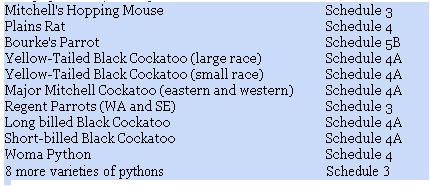
Concerns:
Schedule 4A means that there's no licence for commercial trade or possession. There will be little regulation for this species and they will be sold at market. They will end up similar to gold fish or canaries, with no guarantee for their welfare or specialised social, spatial and environmental needs.
4. Regulatory Impact Statement
“Wildlife enthusiasts will benefit from continued recreational wildlife ownership opportunities and businesses that possess, trade or use wildlife will benefit from a well- managed, legal and robust industry”.
The AWPC opposes industrialisation or the commercialisation of wildlife. The idea of a “robust” industry is contrary to the aim of conservation and animal welfare policies of the AWPC. We do not want or support the economic growth of “industries” associated with wildlife, unless they support their holistic conservation and education of the public.
5. Monitoring and Enforcement
“Monitoring of licence holders will be carried out through targeted and random inspections of premises and record books by DSE Wildlife Compliance Officers or in response to suspected illegal activity or non-compliance with the requirement to submit annual returns”.
If there are enough Victorian government personal resources for these random inspections, they should include random inspections of property owners before they are able to lethally “control” (kill) wildlife.
Wildlife Farmer Licence
The AWPC do not approve of “farms” of wildlife. Emu farms means that emus become another exotic “meat” source and end up bred in captivity, contrary to our policies. Emus belong to the oldest living family of birds on earth, the rarities or flightless fowl. They are nomads, designed by 90 million years of evolution to roam over vast tracks of land.
Subjecting emus with their long thin necks and legs, and large fragile eyes, to transport is cruel and inhumane. Slaughter bound birds and mammals are typically starved for hours, even days before they are killed. Hauled in all kinds of weather, they are forced to endure truck vibrations, heat, stress, cold, damp, thirst and terror. They are then shot with a captive bolt, like cattle or, like poultry, electrically shocked (not stunned) and then hung upside down to have their throats cut, being kept alive when their blood drains. They are slaughtered at 12-15 months of age. This is degrading, and trivialising these unique birds. Adding any “game” birds to this farming category is unconscionable and unethical.
Game Bird Farmer Licence
“Allows the holder to farm game birds that have been bred in captivity for the purpose of releasing them on a specified premise for hunting (from Part A of Schedule 5 and specified in the licence)”.
We do not believe in the recreation of hunting wildlife. Breeding in captivity for hunting is akin to canned hunting, and is something which is abhorrent to wildlife activists and lovers.
Attachment (A ) - Key changes in the proposed Wildlife Regulations 2013
“Wildlife Controller Licence Allows the holder to take wildlife from the wild and to destroy, dispose of or sell that wildlife for the purpose of removing danger to persons or property from that wildlife (from Schedule 6, and specified in the licence)”.
Examples of species that may be controlled under this licence are venomous snakes, deer, Common Brushtail Possums and Sulphur-crested Cockatoos”.
Deer are NOT Australian wildlife. Common Brushtail Possums and Sulphur-crested Cockatoo never endanger human lives, and there are non-lethal methods of deterring their impacts.
Possums are native wildlife. All native wildlife is protected under the Wildlife Act 1975. There are non-lethal ways of dealing with possums, such as relocation and trees and gardens around our houses provide modified woodland similar to their natural habitat. People and possums can live together successfully.
There are companies that supply engineering controls for cockatoos, including ultrasonic devices, kites and other visual deterrents, low voltage shock tape, birdspikes and noise deterrents.
[Any Proposal for a Commercial Kangaroo Industry in Victoria..].
AWPC advises that should consideration be given to the introduction of a commercial Kangaroo industry into Victoria, the following must be carefully read and understood before any final decisions are made.
Weekly Times article favours commercial kangaroo culls
“The ban on commercial processing of culled kangaroos in Victoria must be lifted, the Competition and Efficiency Commission has told the State Government. A draft commission report said the ban appeared ‘unnecessarily burdensome’. The Weekly Times asked Victorian Environment Minister Ryan Smith for comment on the issue, but was referred instead to the office of Treasurer Kim Wells... The commission also called on the Government to simplify the process for obtaining permits, estimating the cost of issuing each Authority to Control Wildlife Permit (ATCW) was about $480... ‘Taking into account the need for a site visit and the rigor of the permit system...yields an administrative cost of approximately $480, or $863,000 across industry”, the VCEC report said.
Victoria is the only mainland state to prohibit commercial processing of its kangaroos...” Source: Peter Hunt, 'Processing Ban ROO-Turn, Hop to it', Weekly Times, April 6, 2011.
Relative to the above Weekly times article, AWPC Submits:
"The density of grey kangaroos in western Victoria and south-eastern South Australia is only 15% of that recorded for the pastoral zone of New South Wales. Such low densities reflect the effect of intensive land use and the marginal nature for kangaroos in remaining areas of natural vegetation.” With exponential human population growth and devastation of a prolonged drought, a commercial kangaroo ‘harvest’ for Victoria would be economically unviable/ unsustainable. Kangaroos are facing more threats than ever today, with the 13 year long drought, tragic bushfires, loss of gene pool, urban expansion, floods, disease and climate change factors. Why push them further into ‘extinction’ mode, and threaten their survival even further? This is what commercial profits for kangaroo meat will do.
Kangaroo meat was classified as Game Meat in 1989 by a Game Meat Working Party, established by the Federal Government. The decision to remove kangaroos from the protected List and change their status to Game Meat was made because: (a) Kangaroo meat could not meet domestic health standards and (b) No animal welfare or conservation groups were present
Fevered Meat
Ramifications of fevered meat entering the food chain is explained by Dr John Auty, Historian, Veterinarian and former Federal Bureau of Animal Health, Canberra, ACT.
“Meat hygiene standards require for all classes of animals that any condition that can cause elevation of body temperature has the potential to cause the condition known as ‘fevered’ meat. Such meat is unsuitable for human consumption.
A condition causing blindness in kangaroos, stress, inability to eat or to find water, elevation of body temperature etc. should result in condemnation of the meat from such diseased animals. It is immaterial if this condition causes generalised septicaemia or not”.
“Kangaroo shooters are not competent to judge disease in animals ante mortem unless the disease is well advanced and it is not in their economic interests to reject animals (kangaroos)”.
“The Australian Quarantine and Inspection Service (AQIS) inspectors inspect kangaroos only after they are transferred to coastal BONING establishments i.e. after they have been eviscerated in the field. Such meat hygiene standards are not acceptable for domestic animals”.
“Whereas the diseases that affect domestic animals are well understood and form the basis for modern meat hygiene, the diseases affecting kangaroos are virtually unknown and there are virtually no Veterinarians based in the areas in which kangaroos are shot”.
How Clean is the Kill?
“Kangaroos are wild animals shot in the outback and they lay on the ground with the flies, airborne bacteria, faeces of other animals and other contaminants. Some of the diseases associated with kangaroo meat are:
*Salmonellae *Coxiella *Sarcocysts *Nematodes *Fasciolia Hepatic Flukes *Subcutaneous and Musculature Cysts *Hydatid Cysts Kangaroos carry internal and external parasites and a range of diseases
Background
The outbreak of a blindness disease infection (Choroid Blindness) which spread across four states in the years ’94, ’95, ’96 caused the death of an estimated one million kangaroos and represented a serious ecological problem to kangaroo populations. Government attempted to keep the issue out of the public arena and displayed ineptitude and an appalling lack of responsibility.
Blind kangaroos were killed or died after jumping in front of traffic, drowning after falling into flowing rivers or starving because they could not find pasture. Source: AWPC 1999. ‘Diseases in Kangaroo Meat’ in The Kangaroo BETRAYED, Hill of Content Melbourne, pp 31-33)
Kangaroos and wallabies can harbour a wide range of parasitic, bacterial, fungal and viral diseases and the majority of infections are unapparent (i.e. animals appear normal). Even meat inspection procedures are unlikely to detect some infections unless gross lesions are detected or routine samples are taken for microbiological and pathological testing.
Worldwide, it is recognised that so-called ‘game meats’ are a source of these infections for hunters, processors and consumers, especially when care is not taken while eviscerating and handling the carcasses or when the meat from these animals is served undercooked or raw. Trichinosis, cysticercosis and toxoplasmosis are examples of parasitic zoonoses (i.e. diseases transmissible from animals to humans).
In Australia, Toxoplasmosis and the bacterial disease, Salmonellosis are two infections with public health significance directly related to the handling, processing and consumption of kangaroo meat. The October issue of Woman’s’ Day (1995) reported that a food-borne outbreak of toxoplasmosis caused acute clinical illnesses in 12 humans and one case of congenital chorio-retinitis (inflammation of the eye tissues) in a new born baby. The mother of the affected baby together with the 12 other people had attended a Christmas function at which rare kangaroo medallions were served. A thorough epidemiological investigation concluded that the most likely ‘risk food’ was the kangaroo meat.
Even ‘new’ human diseases have been shown to have origins in Australian game meat. In 1993 the first confirmed human case of Pseudotrichinosis was diagnosed. The medical investigators concluded that the patient became infected in Tasmania through eating meat, most probably derived from a wild animal. Subsequent research conducted at the University of Tasmania showed that about 2% of Tasmanians surveyed had antibodies to this muscle-encysting nematode.
Professor John Goldsmid, Lecturer in Microbiology at the University of Tasmania expressed his scientific concerns about the lack of research into a range of diseases and parasites transmissible between Tasmanian native animals and humans.
Australia has no dedicated research or diagnostic facility to investigate wildlife diseases. Detections of new diseases are handled on an ad hoc basis by government or university laboratories.
Possums trapped overnight in wire cages (comparable to that described in the brush possum code) show that cage distress and attempts to escape causes muscle damage comparable to capture-stress myopathy of deer. Tasmania is the only State of Australia listed by the WHO as having endemic trichinosis in its wildlife. The Tasmanian Department responsible for permitting a game meat industry denied there was a public health risk associated with the harvesting and processing of Tasmanian possum. Tasmanian wildlife harbour parasitic diseases which are serious infections in humans.
A recent scientific report of the International Health Organisation, the Office Internationale des Epizootes warns that wild animal meats which are raw, undercooked, dried or cold-smoked are potentially infectious to animal or humans that consume them.
The incidence of Toxoplasma abortions and infertility is amongst the highest in Australia. Free ranging wallabies, pademelons, bandicoots and wombats are regularly killed by this infection and surveys show a high percentage of wallabies harbour this infection.
The concern is that chefs and food raconteurs recommend cooking methods which would not kill this parasite.
A newly identified worm thought to be derived from marsupials was found to be responsible for acute illness in two humans. Like Trichinella they invade muscles. The worms are thought to belong to a class of nematodes known as Muscpiceoids. In wallabies and possums these nematodes live in several tissues of the body and can invade muscles.
In his paper to the University of Tasmania (1997 114 ), Professor John Goldsmid said, "Kliks (1983) identified the aetiological agents of human infectious diseases as "heirloom" or "souvenir" species, depending on their evolutionary association with humans. Amongst the most important of the souvenir species are the zoonotic infections, infecting humans as a result of animal-human contact of some kind and varying from companionable contact to utilisation of animals as a food source.
In the last 25 or so years, of 35 new or newly recognised infections in humans, 20 (57%) have been zoonotic in origin - some trivial, some devastating to both the individual and the community.
With the increase in the numbers of immunocompromised people in the community resulting from medical treatment or as a result of the spread of AIDS, the problem of zoonotic infections will continue and there seems little doubt that the likely source for many of these new human infections in Australia will be the native animal population.
People who eat undercooked wallaby or kangaroo meat could be at risk of infection by a newly-discovered animal parasite, Australian doctors have warned. The parasite was found in a Tasmanian man who suffered from inexplicable and severe muscle weakness over a number of years. He was known to consume large quantities of game. ("Parasite Risk to Game Eaters" November 7, 1997 Animal Pharmacology No. 384)
Laboratory tests suggests that the parasite is a new species of microscopic worm. It may also have been responsible for a similar infection in a New Zealand woman who had eaten wallaby meat while visiting Tasmania.
"The cases highlight the risks of eating wild game, the parasites of which are poorly understood compared with those of livestock. More studies are needed to identify disease agents in these animals and to elucidate the role of native animal species in the transmission of diseases to humans."
Victorian Competition and Efficiency Commission (VCEC) call for commercial kangaroo industry
Victoria has no fauna management framework;
Victoria has no scientific kangaroo population data. Given there is no population data, commercial utilization is economically unviable and unsustainable for survival of kangaroos.
DSE data base fails threatened species
Roads are a Threatening process
Genetic variability / Wildlife Corridors and to re-connect bio-links to save species
Human induced threats and self-limiting factors control kangaroo populations
Climate change/ population growth driving species to extinction Climate change/ population growth driving species to extinction
DSE has a Duty of Care -Kangaroos are not a Commodity to be bartered and sold
We know that overwhelmingly, it is mostly ‘hobby farmers’ who seek ATCW permits. We seek Regulations for ATCW permits to be issued only to landowners whose sole income is from legitimate farming, as opposed to ‘hobby’ farmers for tax deductibility write offs.
Left just with the sole income farmers, this becomes an area that needs education/ awareness of productive farming in harmony with biodiversity and ecosystems; Learn to live with wildlife.
This is the only way to stop the ethically, morally and humanely deficient and farcical practice of DSE issuing ATCW kill kangaroo Permits in Victoria.
Prove that the ATCW permits DSE gives away like candy are legitimate, with tight conditions
This is particularly pertinent to wildlife carers who already suffer from ATCW permits given to adjoining landowners placing at risk the very kangaroos they have a license to hand rear.
Under the current system it costs Victorian tax payers for landowners to kill protected kangaroos without their say or consent; (yet taxpayers have to pay hefty $$$ for FOI)
Why then is this cost not passed onto the landowner if they are benefitting from it?
DSE data base fails kangaroos and threatened species
In Victoria 2006, Exec Director Dr Ian Miles arranged for Department of Sustainability and Environment (DSE) Adrian Moorrees, Project Manager, Actions for Biodiversity Conservation (ABC), Biodiversity and Ecosystem Services Division to demonstrate to AWPC, the DSE Actions Biodiversity Conservation (ABC) Data Base system. We discovered that “DSE uses an inadequate Victoria-wide definition of ‘threatened’ which means that local populations can be extinguished without sounding the alarm so long as some numbers remain for the whole state ; pockets where animals appear numerous, due to fragmented populations trapped in small areas, are not assigned official ‘threatened’ status. Little effective tab is kept of numbers. More and more native species simply vanish, Sheila Newman, Environmental and Land Use Planning Sociologist for the Australian Wildlife Protection Council.
In Hamilton the west of the state, will argue that every other state has Environment Australia-approved management plans to harvest kangaroos for export. But in Victoria kangaroos are culled only for damage control. Annually, 9000-30,000 animals are authorised to be destroyed. The council will argue there is a potential commercial use for these kangaroo products, but current regulations did not allow culled kangaroos to be moved from where they died.
Ms Wolf-Tasker said it was "wonderful to see a council being pro-active on this''. "We've used kangaroo meat here for a decade but because of Victoria's rule we have to buy it from South Australia, despite kangaroos being culled here,'' she said. "Kangaroo is a great, healthy product. "It is has a more gamey flavour and is one of the last wild foods. "It is wonderful to use it with locally-grown indigenous plants from this area, such as the mountain pepper.'' Ms Wolf-Tasker said consumers increasingly wanted to know where their meat came from and kangaroo was a very popular, "natural, wild food''.
Despite concerns raised by some animal rights groups over using kangaroo meat for human consumption, Ms Wolf-Tasker said if the "necessary culling was properly regulated, using the meat for human consumption could prevent the waste of what is a very good product''. She said kangaroos needed to be culled when in plague proportions because they "caused havoc on farms and in the local environment''. A spokeswoman for Environment Minister Ryan Smith said yesterday the State Government was evaluating the feasibility of commercial harvesting of wild kangaroos with advice from the Department of Primary Industries. "We will await the outcome of that work before making decision about possible changes to regulation to allow commercial kangaroo harvesting,'' she said.
http://www.weeklytimesnow.com.au/article/2012/09/12/536971_business-news.html
THINKK TANK
THINKK, the think tank for kangaroos, based at the University of Technology Sydney and supported by Voiceless, released two reports late last year examining the killing of kangaroos in Australia. Each year over three million kangaroos are ‘harvested’ and over a million joeys are killed as part of the commercial industry. This is the largest land-based slaughter of wildlife in the world.
The reports, titled “Advocating kangaroo meat: towards ecological benefit or plunder?” and “Shooting our wildlife: An analysis of the law and policy governing the killing of kangaroos”, conclude that:
emerging science indicates that kangaroos are not pests;
over 20 years of harvesting kangaroos has had no demonstrable environmental benefit;
increased consumption of kangaroo meat by humans is likely to place kangaroo populations at risk;
State governments once treated kangaroos as agricultural pests yet today they are treated as a resource;
The current law is a form of legalised cruelty.
Please download the reports by following this link. http://www.voiceless.org.au/About_Us/Misc/THINKK_the_think_tank_for_kangaroos.html
For additional information about THINKK, please visit their website at http://thinkkangaroos.uts.edu.au.
From Conservation to Exploitation in South Australia
“In any wild animal if you disrupt in a short period of time the normal reproduction processes that have evolved over tens of thousands of years you are in danger of putting the species at risk. Precedents have been set in other parts of the world where large populations of a species ( seals. Bison, wolves etc) have faced extinction after widespread and destructive ‘culling’ programs. Many of these species suffered incursion of exotic bacterias and viruses when their populations contained a critical and unsustainable gene pool.
To be able to undertake the largest wildlife slaughter in the world today it was necessary to undertake a long and sustained program of misinformation within Australia to convince the community that these animals are in plague proportions throughout the country areas of Australia. This was achieved by presenting he animal as a “resource” that needed to be exploited. A program of ‘shoot and let lie’ would have avoided the introduction of commercial pressures (COOMA, ACT and surrounds + MUDGEE and surrounds) on the wild animals and forced the introduction of the less destructive commercial ‘alternative’.
Where farmers and pastoralists (with sheep, cattle and crops) are in competition with any native animal, the government administrators always favour the land owner. Whatever native animal is involved, that animal is marked for destruction.
There are many examples of this entrenched ‘destructive culture’, now being undertaken in South Australia.” Source: Chapter ‘From Conservation to Exploitation in South Australia’ by Doug Reilly Macropod expert in the AWPC 1999 publication, The Kangaroo BetrayedHill of Content, Melbourne, p.37.
Respectfully Submitted,
Maryland Wilson President
Vivienne Ortega Vice President
Cienwen Hickey Research
Sheila Newman Environmental Sociologist Land Use Planner
 The seventh of September is a sombre day to acknowledge raising the plight of all our threatened species in Australia. As some politicians will have the opportunity to hold cute furry wildlife and many will advocate for stronger laws to protect nature and seek to increase funding for species recovery.
The seventh of September is a sombre day to acknowledge raising the plight of all our threatened species in Australia. As some politicians will have the opportunity to hold cute furry wildlife and many will advocate for stronger laws to protect nature and seek to increase funding for species recovery.
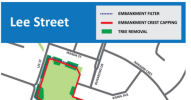
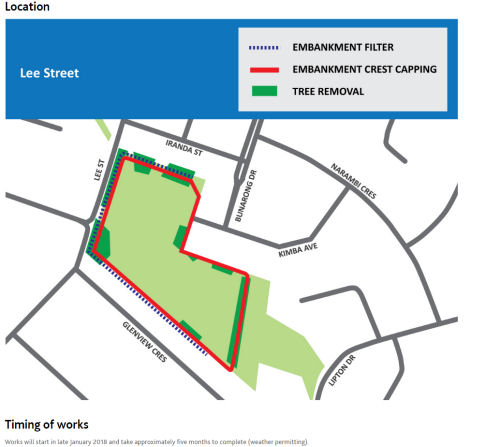

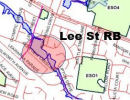 Alan Hood is a Flood Researcher. Melbourne Water owns this Retarding Basin and their maintenance contractor, John Holland - KBR Joint Venture intend removing trees and various works in "late January" - any day now. This could be an attempt to cater for increased suburban stormwater runoff without increasing the capacity of the chain of retarding basins. Although prepared for dams which would normally be at least 10 to 15 m high, ANCOLD guidelines can also be used to assist with decisions on smaller dams, particularly where such dams create potential loss of life or significant damage. The attached Planning map shows Special Building Overlays (SBO) for Frankston; the identify areas likely to be flooded. If the Lee St Retarding Basin batters are at least 10 to 15 metres high, there might be some justification for removing the trees, but see more inside this article. [Introduction written by candobetter.net editor.]
Alan Hood is a Flood Researcher. Melbourne Water owns this Retarding Basin and their maintenance contractor, John Holland - KBR Joint Venture intend removing trees and various works in "late January" - any day now. This could be an attempt to cater for increased suburban stormwater runoff without increasing the capacity of the chain of retarding basins. Although prepared for dams which would normally be at least 10 to 15 m high, ANCOLD guidelines can also be used to assist with decisions on smaller dams, particularly where such dams create potential loss of life or significant damage. The attached Planning map shows Special Building Overlays (SBO) for Frankston; the identify areas likely to be flooded. If the Lee St Retarding Basin batters are at least 10 to 15 metres high, there might be some justification for removing the trees, but see more inside this article. [Introduction written by candobetter.net editor.]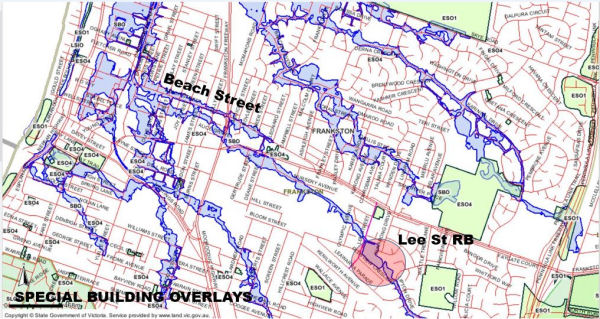 The Australian National Committee on Large Dams says: “ANCOLD guidelines are applicable for water or tailings dams with potential to cause loss of life or significant environmental or physical damage through operation or failure.
The Australian National Committee on Large Dams says: “ANCOLD guidelines are applicable for water or tailings dams with potential to cause loss of life or significant environmental or physical damage through operation or failure.  Melbourne Water is about to de-tree Frankston koala corridor by removing mature trees from banks of a huge park with a water retarding basin in it at Lee Street Frankston 3199. They are claiming that the trees are 'destabilising' the banks. But of course the trees are holding the banks together and keeping the water-table down. Who is accountable for these kinds of decisions that are based on what sound like lies that make no sense? Frankston Council is apparently going along with this. It seems totally insane and anti-life and nature. Inside is a video alerting us to the details.
Melbourne Water is about to de-tree Frankston koala corridor by removing mature trees from banks of a huge park with a water retarding basin in it at Lee Street Frankston 3199. They are claiming that the trees are 'destabilising' the banks. But of course the trees are holding the banks together and keeping the water-table down. Who is accountable for these kinds of decisions that are based on what sound like lies that make no sense? Frankston Council is apparently going along with this. It seems totally insane and anti-life and nature. Inside is a video alerting us to the details. 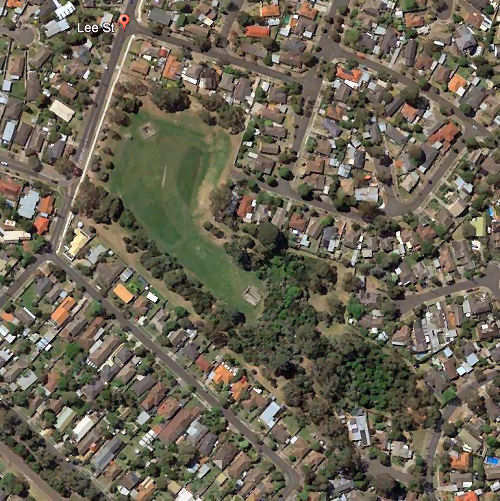
 Wildlife rescuer and carer, Rebecca Koller, has observed an unprecedented number of Spectacled flying fox casualties in a traditional breeding site located near a new hotel construction in Cairnes. The spectacled flying fox is a threatened species.[1] Despite many attempts to get the Australian government to investigate and or intervene, the government has failed to get back to her. This is even though the problem has received extensive publicity and the species is about to have its threatened status upgraded from vulnerable to endangered. The source of this article is correspondence between Ms Koller and The Australian Wildlife Protection Council.
Wildlife rescuer and carer, Rebecca Koller, has observed an unprecedented number of Spectacled flying fox casualties in a traditional breeding site located near a new hotel construction in Cairnes. The spectacled flying fox is a threatened species.[1] Despite many attempts to get the Australian government to investigate and or intervene, the government has failed to get back to her. This is even though the problem has received extensive publicity and the species is about to have its threatened status upgraded from vulnerable to endangered. The source of this article is correspondence between Ms Koller and The Australian Wildlife Protection Council.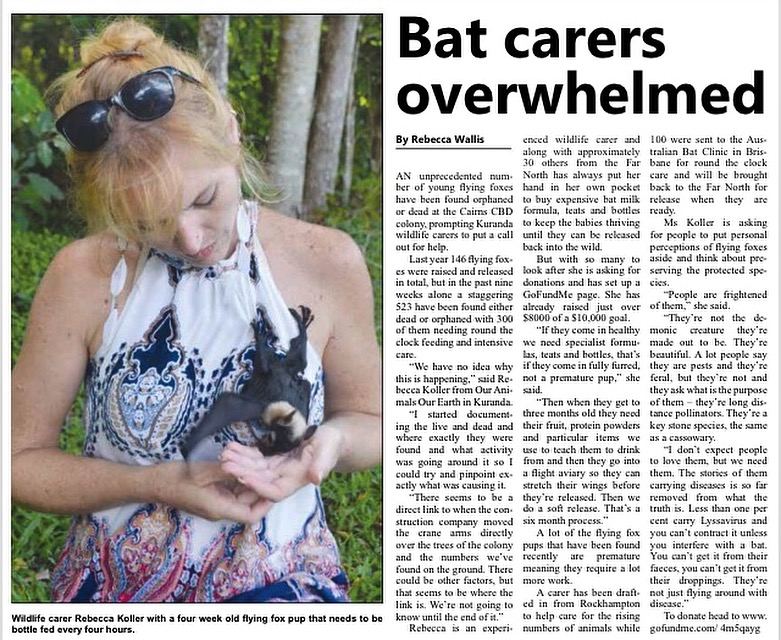
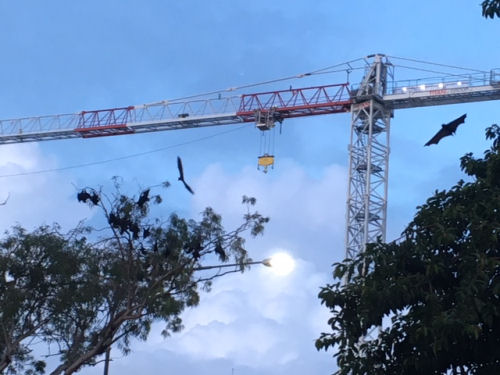
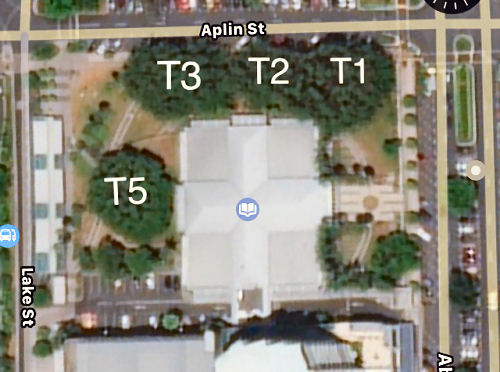


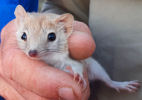 A Crest-tailed Mulgara, a small carnivorous marsupial known only from fossilised bone fragments and presumed extinct in NSW for more than century, has been discovered in Sturt National Park north-west of Tibooburra.
A Crest-tailed Mulgara, a small carnivorous marsupial known only from fossilised bone fragments and presumed extinct in NSW for more than century, has been discovered in Sturt National Park north-west of Tibooburra.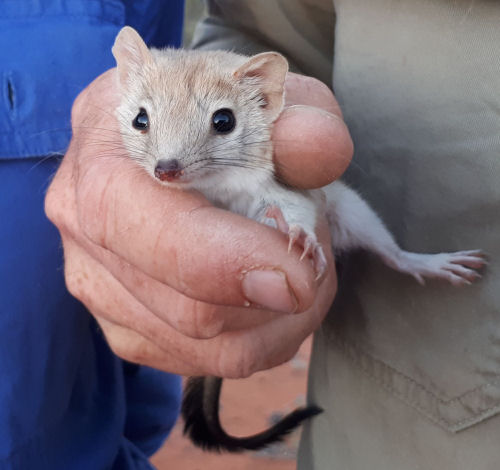
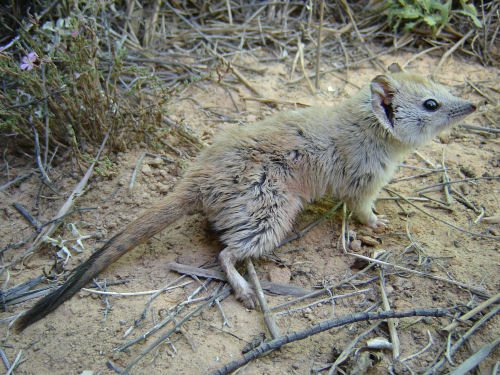


 This scientific study into the endangered Growling Grass Frog was released overnight and looks at how the genetic diversity of the frog is being negatively impacted by the rapid urbanisation of Melbourne’s fringe. They were once very abundant in Victoria (so abundant that they used to feed them to the snakes the Melbourne Zoo!) and now only a few populations exist around Melbourne.
This scientific study into the endangered Growling Grass Frog was released overnight and looks at how the genetic diversity of the frog is being negatively impacted by the rapid urbanisation of Melbourne’s fringe. They were once very abundant in Victoria (so abundant that they used to feed them to the snakes the Melbourne Zoo!) and now only a few populations exist around Melbourne. 
 Compassion was a far more effective environmental management tool than “poison and guns,” award winning ecologist Dr Arian Wallach told a recent conference of conservationists and farmers. And dingoes were an ideal agent for saving the environment and promoting co-existence between native and exotic species. The May 17, 2015 conference, “Dingo – Friend or Foe” was held at Hervey Bay Community Centre, just across the Great Sandy Straits from World Heritage listed Fraser Island where, it was argued, Australia’s war on the dingo began. Three prominent local farmers, Harry Jamieson, Lindsay Titmarsh and James Hansen told the conference of dingo problems, worse in recent years than ever before. (Article by Arthur Gorrie. )
Compassion was a far more effective environmental management tool than “poison and guns,” award winning ecologist Dr Arian Wallach told a recent conference of conservationists and farmers. And dingoes were an ideal agent for saving the environment and promoting co-existence between native and exotic species. The May 17, 2015 conference, “Dingo – Friend or Foe” was held at Hervey Bay Community Centre, just across the Great Sandy Straits from World Heritage listed Fraser Island where, it was argued, Australia’s war on the dingo began. Three prominent local farmers, Harry Jamieson, Lindsay Titmarsh and James Hansen told the conference of dingo problems, worse in recent years than ever before. (Article by Arthur Gorrie. )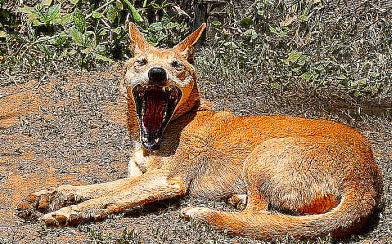 Researcher and grazier Adam O’Neill said the national “war on the dingo” which followed the death of a boy, Clinton Gage on Fraser Island in 2001 had caused a significant worsening of the problems it was supposed to address.
Researcher and grazier Adam O’Neill said the national “war on the dingo” which followed the death of a boy, Clinton Gage on Fraser Island in 2001 had caused a significant worsening of the problems it was supposed to address. This article describes the important contribution of bandicoots to tree health and ecology. It raises the much wider costs of bandicoot extinction and tree die-off associated with such extinction.
This article describes the important contribution of bandicoots to tree health and ecology. It raises the much wider costs of bandicoot extinction and tree die-off associated with such extinction. Bandicoots are a unique marsupial abut the size of a guinea pig. Females have a pouch like kangaroos but their pouch is opening backwards so that the young have to get in and out through the “backdoor”. This is because bandicoots dig in the soil for grubs and, hence, would fill their pouch with soil.
Bandicoots are a unique marsupial abut the size of a guinea pig. Females have a pouch like kangaroos but their pouch is opening backwards so that the young have to get in and out through the “backdoor”. This is because bandicoots dig in the soil for grubs and, hence, would fill their pouch with soil. Inappropriate fuel-reduction could see more losses of threatened species.
Inappropriate fuel-reduction could see more losses of threatened species.



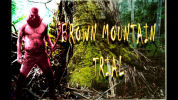
 Jill Redwood, as coordinator of Environment East Gippsland, conducted a landmark environmental court case that saw her group awarded damages against the Government Forestry corporation, VicForests, who were told to conduct proper investigations for the presence of threatened species in areas they logged and to design and enact plans to safeguard them according to the law. Three years later the Giant Trees Walk on Brown Mountain, which EEG had created in order to develop awareness of the rape of East Gippsland's forests, has been destroyed by persons unknown, equipped with heavy equipment and chainsaws.
Jill Redwood, as coordinator of Environment East Gippsland, conducted a landmark environmental court case that saw her group awarded damages against the Government Forestry corporation, VicForests, who were told to conduct proper investigations for the presence of threatened species in areas they logged and to design and enact plans to safeguard them according to the law. Three years later the Giant Trees Walk on Brown Mountain, which EEG had created in order to develop awareness of the rape of East Gippsland's forests, has been destroyed by persons unknown, equipped with heavy equipment and chainsaws. The Australian Wildlife Protection Council wrote on September 1, 2014 to the Senate Standing Committees on Environment and Communications: "We condemn the Abbott Government’s attacks on the Great Barrier Reef, other priceless environmental institutions and native wildlife across Australia. We are dismayed by their lack of environmental protection since [the Abbott Government's]coming to power."
The Australian Wildlife Protection Council wrote on September 1, 2014 to the Senate Standing Committees on Environment and Communications: "We condemn the Abbott Government’s attacks on the Great Barrier Reef, other priceless environmental institutions and native wildlife across Australia. We are dismayed by their lack of environmental protection since [the Abbott Government's]coming to power."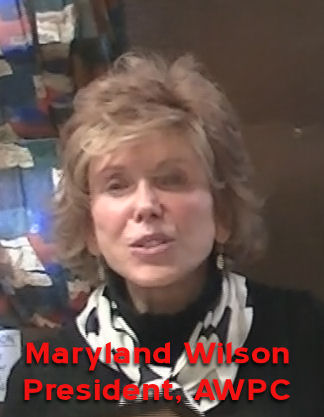 We express our shock and disgust at the attitude of the Coalition Government for their failure to see how important our environment is to many of us. It provides us with clean air, water, food - the essential elements of life for all species on this planet. Barnaby Joyce, Christopher Pyne, Warren Trusss, Eddie Abetz, too many Coalition M.P.’s and Ministers, treat the environment with total contempt [and] disregard!
We express our shock and disgust at the attitude of the Coalition Government for their failure to see how important our environment is to many of us. It provides us with clean air, water, food - the essential elements of life for all species on this planet. Barnaby Joyce, Christopher Pyne, Warren Trusss, Eddie Abetz, too many Coalition M.P.’s and Ministers, treat the environment with total contempt [and] disregard!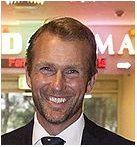

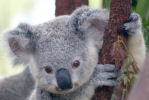
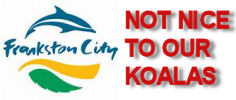 It is shocking to hear that several Frankston Councillors have voted to build over the last koala corridor in this crucial area. Craig Thomson has made a Submission to Frankston Council item 11.8 AGAINST Request for a Planning Scheme amendment to REMOVE 42 hectares from the Green Wedge Conservation Zone to allow 350 houses to be built. He says, "The land is a vital Koala migration route- it means local extinction of koalas in South Frankston. The VOTE was close 5 to 4 against the koalas. The next step for this item is for further community consultation and the Planning scheme amendment to go before the Minister."
It is shocking to hear that several Frankston Councillors have voted to build over the last koala corridor in this crucial area. Craig Thomson has made a Submission to Frankston Council item 11.8 AGAINST Request for a Planning Scheme amendment to REMOVE 42 hectares from the Green Wedge Conservation Zone to allow 350 houses to be built. He says, "The land is a vital Koala migration route- it means local extinction of koalas in South Frankston. The VOTE was close 5 to 4 against the koalas. The next step for this item is for further community consultation and the Planning scheme amendment to go before the Minister."

 In this save the birds campaign, Paul Sullivan, the Chief Executive Officer of Birdlife Australia, writes of how frustrated he is that the major parties are just ongoing standing by while birds and other creatures go extinct. He argues (as if it should be necessary) that it would cost very little money to save each threatened species. He does not mention how overpopulation, overdevelopment and agriculture are eating up habitat, but you know...
In this save the birds campaign, Paul Sullivan, the Chief Executive Officer of Birdlife Australia, writes of how frustrated he is that the major parties are just ongoing standing by while birds and other creatures go extinct. He argues (as if it should be necessary) that it would cost very little money to save each threatened species. He does not mention how overpopulation, overdevelopment and agriculture are eating up habitat, but you know...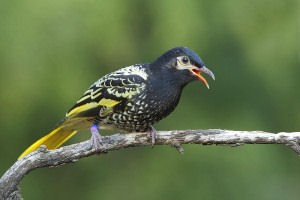 [Does anyone know the name of th pictured bird? It is on the Birdlife Australia website as an endangered species but has no label. Please write in and tell us.]
[Does anyone know the name of th pictured bird? It is on the Birdlife Australia website as an endangered species but has no label. Please write in and tell us.]


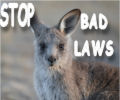 The Australian Wildlife Protection Council (AWPC) is gravely concerned by the ‘use and commercialisation of Australian native animals’, their extinction rates, cruelty inflicted on them, and recreational hunting. Even more so, given that Australia has the world’s highest extinction rate. Instead of apologising for crimes against nature, the Victorian State Government seeks to extend further exploitation.
The Australian Wildlife Protection Council (AWPC) is gravely concerned by the ‘use and commercialisation of Australian native animals’, their extinction rates, cruelty inflicted on them, and recreational hunting. Even more so, given that Australia has the world’s highest extinction rate. Instead of apologising for crimes against nature, the Victorian State Government seeks to extend further exploitation. 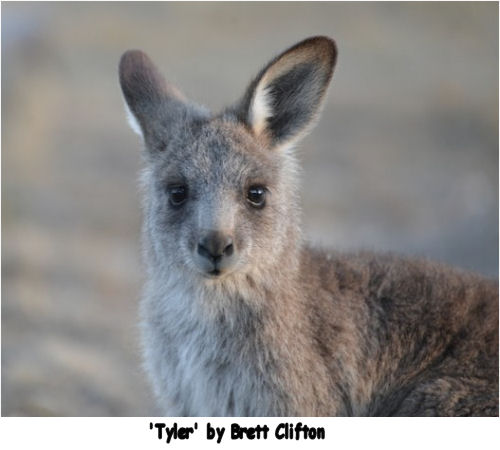


 Twenty thirteen awaits us tomorrow. What is reasonable to expect of the year which some may see as being an unlucky number? Should we reach for the sky or just try to maintain business as usual?
Twenty thirteen awaits us tomorrow. What is reasonable to expect of the year which some may see as being an unlucky number? Should we reach for the sky or just try to maintain business as usual?
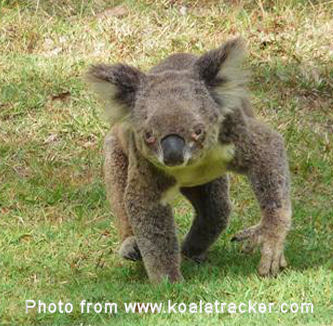
 "Minister Burke has ruled out protection for all koalas and we are concerned these northwest NSW koala populations may be left off the threatened species list, even while their populations are falling dangerously low." Zoologist David Paull: 75 per cent decline in the relative abundance of koalas in the Pilliga from 1993 to 2011. Estimates only 500 to 2000 koalas left in the area. “The spread of mines and gas wells, tree kills from coal seam gas spills and increased vehicles through the Pilliga Forest will likely put extra strain on these already declining koala populations." Wilderness Society, 29 April 2012.(This article elevates to an article a comment "Media Release - The Wilderness Society on Koalas," posted by Bandicoot on April 29-2012.)
"Minister Burke has ruled out protection for all koalas and we are concerned these northwest NSW koala populations may be left off the threatened species list, even while their populations are falling dangerously low." Zoologist David Paull: 75 per cent decline in the relative abundance of koalas in the Pilliga from 1993 to 2011. Estimates only 500 to 2000 koalas left in the area. “The spread of mines and gas wells, tree kills from coal seam gas spills and increased vehicles through the Pilliga Forest will likely put extra strain on these already declining koala populations." Wilderness Society, 29 April 2012.(This article elevates to an article a comment "Media Release - The Wilderness Society on Koalas," posted by Bandicoot on April 29-2012.)
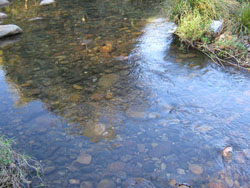
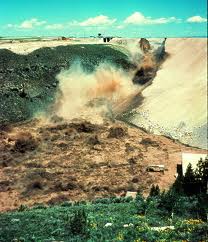

 On the northern coast of N.S.W. adjoining the Gold Coast and S.E.Queensland lies Tweed Shire, christened as the Green Caldera by once Environment Minister Peter Garrett. This area is famous for one of the highest biodiversity levels in Australia and infamous for the greatest level of biodiversity loss in N.S.W. thanks to the fact that the vast majority of Tweed councillors are pro-development. But in the case of Kings Forest, a massive housing development for 15,000 people worth $2 billion, NSW State Planning took control under the massively unpopular Part 3a legislation, depriving the council of all controls.
On the northern coast of N.S.W. adjoining the Gold Coast and S.E.Queensland lies Tweed Shire, christened as the Green Caldera by once Environment Minister Peter Garrett. This area is famous for one of the highest biodiversity levels in Australia and infamous for the greatest level of biodiversity loss in N.S.W. thanks to the fact that the vast majority of Tweed councillors are pro-development. But in the case of Kings Forest, a massive housing development for 15,000 people worth $2 billion, NSW State Planning took control under the massively unpopular Part 3a legislation, depriving the council of all controls.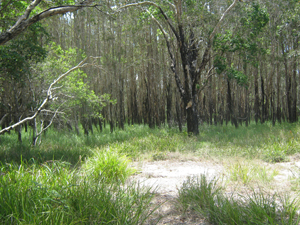 (photo: Cudgen Nature Reserve)
(photo: Cudgen Nature Reserve)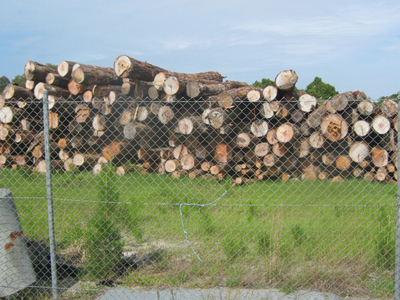


Recent comments